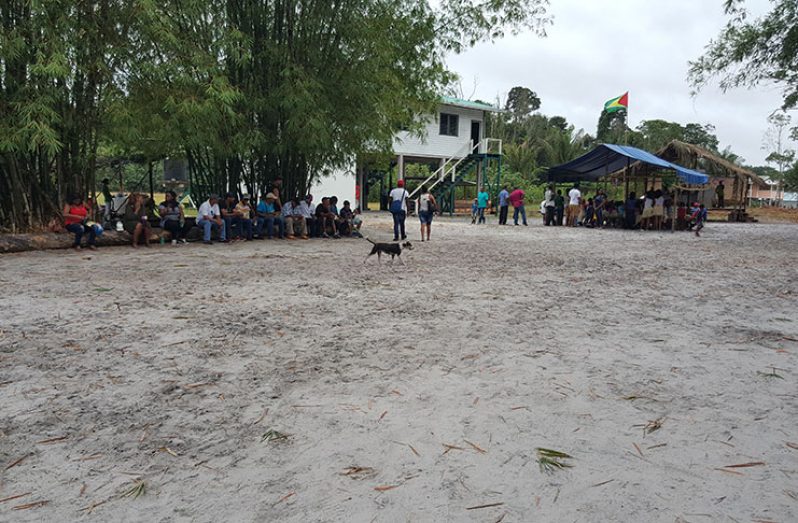–with cultural explosion of dance, poetry, acoustic music
DOZENS of visitors joined residents of Caria Caria, on the Essequibo River on Sunday as they celebrated Amerindian Heritage Day in that community.
The event saw a cultural explosion of dance, poetry and acrostic music, coupled with the vending of Amerindian wines, beverages, and foods from the various booths that were specially constructed for the occasion.
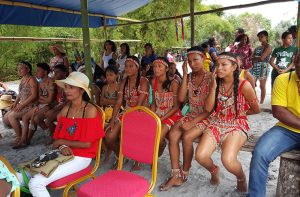
In the absence of Minister of Natural Resources, Raphael Trotman, his representative, Mr Ashton Simon said Caria Caria is a model community, and it is only fitting that Amerindian Heritage was celebrated there with such fanfare, given the large turnout of both residents and visitors.
Simon, who is also President of the National Amerindian Development Foundation (NADF), said the organisation has done a lot of behind-the-scenes work with its leaders in an effort to develop the community.
He also stressed the need for all-weather roads, electricity and potable water in the riverine community, the main source of income of which is from logging, farming and mining.
Guests also heard from the representative of the Regional Democratic Council (RDC) of Region Three (Essequibo Islands-West Demerara), as well as several other invitees who were part of the head table on Sunday during the cultural presentation at Caria Caria.
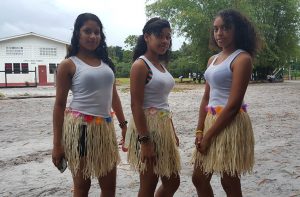
Chairman of the Community Development Council (CDC), Everton Gibson said the organisation consists of 10 members, all of whom are tasked with overseeing the development of the village which has about 300 residents.
BRIEF HISTORY
Giving a brief history of Caria Caria, Gibson said the village has been in existence since 1820 or thereabouts, back when it was run by the Dutch, and the church played a key role in education.

He said that for recreation these days, the children would play outdoor games such as cricket and football. He also spoke about the need for police presence in the village since there are about three bars there.
Bars aside, he said the community boasts several churches, a health centre, a community centre and playground, and a nursery school and Annexe.
Caria Caria is home to a mostly mixed-race peoples of Amerindian, Portuguese, East Indian and African descent.
The Resident Nurse, Everey Sampson, who was a vendor at one of the booths, told the Guyana Chronicle that she has been holding that post for 19 years. She too spoke about the various needs of the community, one of which is roads.
She also hinted at the need for potable water, as every now and again, there is an outbreak of typhoid and diarrhoea in the village, because the water they use is sourced from either the Essequibo River or rainfall.
Sampson was selling her fresh supply of Paiwari, golden apple wine and sarsaparilla wine, along with generous helpings of fried rice and BBQ chicken at the Caria Caria Heritage Day celebrations.
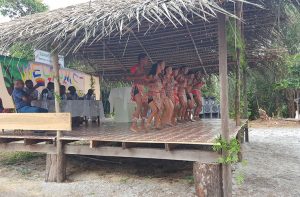
Cecilia Craig, a teacher at the village school, said that among their immediate needs are toys for the smaller children, teaching aids, stationery and other school supplies.
She stated, too, that they also are in need of fuel for the boat which was donated by the Ministry of Indigenous Affairs, which is used for the transport of schoolchildren.
OVERSEAS VISITORS
At the Caria Caria Heritage Day celebrations was Clyde Matthews, a Canada-based Guyanese who was visiting and was very pleased with the atmosphere, which was one of obvious celebration and togetherness.
Yvonne Jacobs, who journeyed with her extended-family from West Coast Demerara to Caria Caria, had her hand-made embroidery, fabric painting and craft products on sale.
Originally from Saxacalli, some 25 miles upriver from Parika, Jacobs said that because her husband is from Caria Caria, she took the family to experience what Heritage Day is like there.
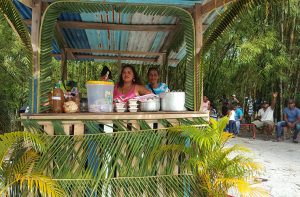
Sharlene Sampson, who resides at Caria Caria, told this publication that life in the remote village is bearable, once you’re prepared to work, since there isn’t much folks there can do for a living.
She had steaming pots of pepperpot labba, hymara, BBQ Chicken, fried rice, chips and various beverages on sale.
The Guyana Chronicle also caught up with Jenette Hohenkirk, who had on sale rice and golden apple wines, paiwari, ‘Fly’, ite palm, cashew and plantain wines, along with various types of seasoned rice with BBQ chicken, deer, labba, wild hog and wild cow.
Being a resident, she said Caria Caria is a very peaceful and quiet place to live, and that come this time every year, she gets to put her culinary skills to the test.
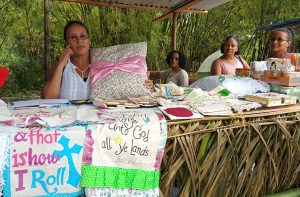
Preetty Debideen, who is the resident Medex for Fort Island and a member of NADF, said she is originally from Mabaruma in Region One (Barima-Waini) but has been living on the island for the past 15 years.
She said that Wakenaam is the closet police station to Fort Island which is located in the Essequibo River and is about an hour’s ride by speedboat to Caria Caria.




.jpg)





